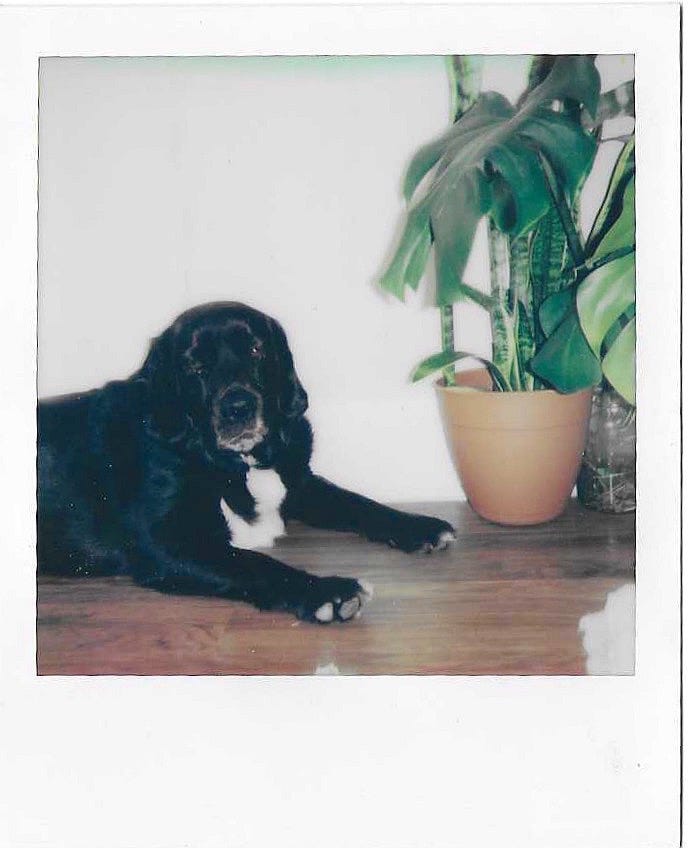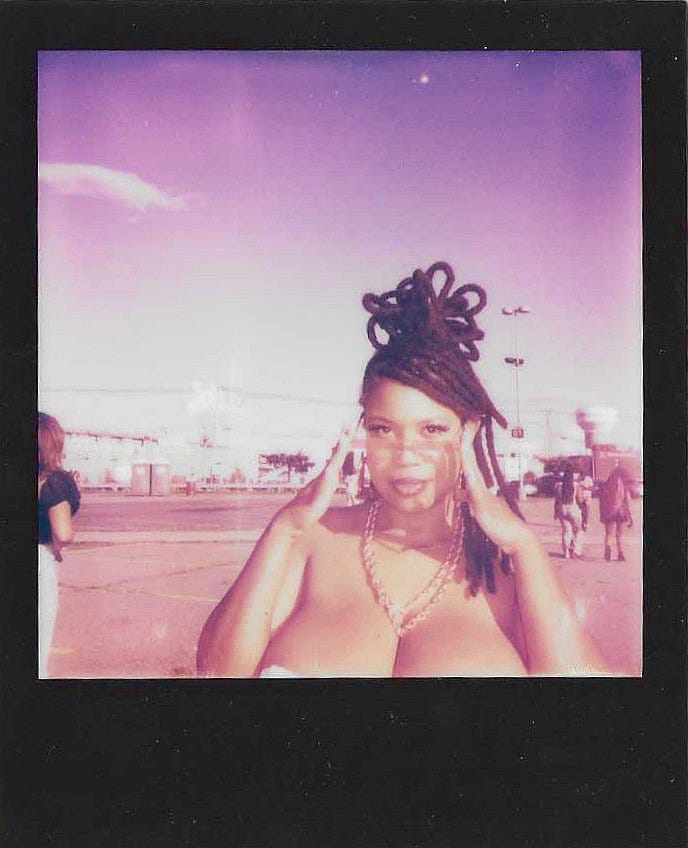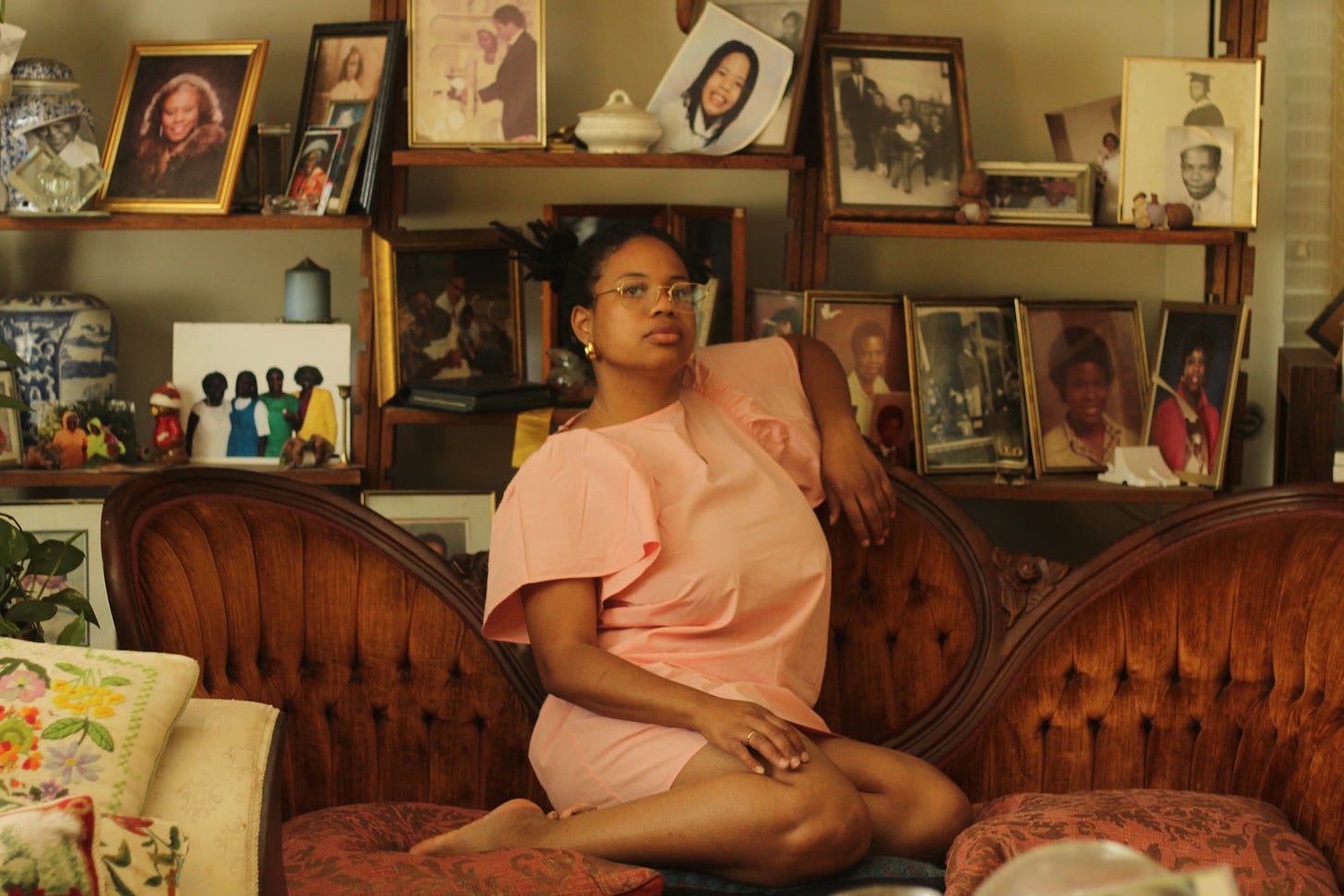Shake it Like A Polaroid Picture
On chasing light & using up film


Recently I've gotten back into instant photography. I bought a Polaroid Now instant camera in late 2020, as a sort of way to create memories with my family during the first pandemic holiday season. We spent Christmas that year spread across Virginia and Maryland, and so as the person tasked with dropping off food to the different houses, I wanted to have a memento since we couldn't be physically close. I dropped off pies and snapped photos to swap with my relatives. It was a cute, kitschy lil something to do.
We are a "picture" family – whether it's a barbecue, a church directory, weddings, funerals, we are going to sit for a photograph. There is the silver gelatin print of my grandmother's family from the late 1800's, an heirloom; there's the formal sitting parlor where one wall is dedicated to dozens of meticulously curated pictures and photo albums chronicling whole eras of my family's life, an altar. Black Southern material culture is so rich and sometimes I forget how enmeshed it is in my daily life.
This year, I decided to use my PolaroidNow to capture more than just family gatherings. I purchased multipacks of film and have been shooting all the best parts of the summer – the sunflower fields at Dix Park, the Beyoncé concert, my friends, my dog. Shooting pictures on your phone is cool & convenient, but working with Polaroids gives you the high of a quick digital picture, but also the tangibility of a physical artifact. And because film only comes 8 shots to a box, you have to be thoughtful about what you shoot because film is limited. You can do cool things like double exposures, which create a ghostly effect with the film is exposed to light multiple times. You also have to navigate the physical limitations of the camera, which means a good photo in your hand is really something to savor. You have to work for it like crab meat.
The best approach to taking pictures, in my opinion, is what I call "love theory". Yes, there are certain things you can do to compose a picture (rule of 3rds, subject matter, etc.), but if you are getting your picture taken or you are taking pictures, YOU BETTER BE IN LOVE. The film doesn't lie. However the photographer feels about the subject will seep into the frame, and the photo will tell on itself.

While on my instant photography journey I came across Steven Hawkins' work on Instagram. He uses peel-apart pack film to take beautiful portraits of people in a very 90s hip-hop magazine sort of fashion. Because I am easily influenced, I went out and bought a vintage land camera (cheap – $25) only to realize that the film it uses is no longer produced. You basically have to buy it second hand and *hope* that the chemicals in the film are still worth a damn (which makes it hella pricey). To become better at using this type of camera means failing, but when film costs between $7.50 - $12 a picture, it means that I have to be thoughtful and fearless about what I shoot. In a way rare film is like life -you don't want to waste what you have, but you don’t want to be too scary to jump out and make something interesting either.
That Polaroid even still exist is a miracle. This PetaPixel piece details the ups and downs of the company, which faced troubles and stopped making the film that goes into Polaroid cameras in 2008. The brand only survived because of the folks behind the Impossible Project, which kept the medium afloat until the Polaroid was formally relaunched in 2017. Now Polaroid has the same retro moment as vinyl records. Hopefully Polaroid or Fujifilm will start making old school pack film again – the cameras that take them are still around and can produce beautiful images! Those companies probably won't do that unless it makes financial sense. In the meantime I'm using my newer Polaroid for color photos, and use my old land camera Polaroid for special events. I have to steward the pack film I can get my hands on because it is so rare.

The fun of working with instant film is that it is both sensory and narrative and on a technical level, poetic. Consider light, the linchpin of a photograph, which travels millions of years into the future to hit the mechanical eye of your camera, which then hits the film to create the picture that pops out and is ready in 20 seconds. How could you not love the convoluted magic of it all?
Victoria Monet's new video for On My Mama ate all the way down. The way my college memories from the turn-of-the-Millennium were activated! Heart so full 💖
Read This:
My friend Will Ketchum interviewed Method Man's fine ass for Men's Health.
Also, a cool interactive situation in the NYTimes for Hip-Hop's 50th anniversary
Fucking yikes: Elon musk’s terrifying grip on foreign and domestic policy
Omg wow! Spiritual and religious practices show benefits and give people a sense of belonging. Perry Bacon Jr. on leaving church and yearning for community.
Tressie’s incisive take on Bama RushTok, and AnneHelen’s primer on the phenomenon.
Watchlist Recommendations:
Ladies First on Netflix (about how women have shaped hip-hop)
Minx on Starz (about a feminist porn magazine in the 70's – trust me)
Food this week
I didn't take a picture but I made this smothered chicken and served it over jasmine rice and a side of cauliflower. A small tweak is that I added diced celery to the onions and garlic while making the gravy. Definitely a grown-ass meal.



“You have to work for it like crab meat” is such a great line!
Hi Terryn- I read the piece profiling you in Culture Study and felt an instant connection. My grandfather was a professional photographer and was the collector and archivist of family photos going back to the late 1800s. I have an envelope of photographs he copied for me featuring great-great-great uncles and aunts who I've never heard of living their daily life in Michigan. My wife and I have a gallery of old family photos from both sides lining the main hallway of our house. I loved reading about your photographic journey and approach, and I agree, there's something that I miss about the intention of non-digital photography. I'm on your list now and looking forward to reading more!